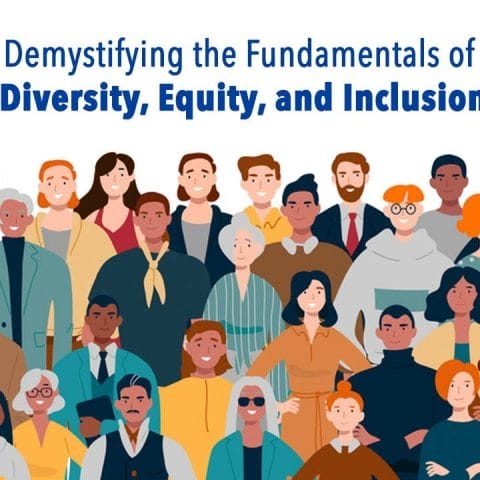Did you know that organizations that prioritize diversity, equity, and inclusion (DEI) training experience a 15% increase in employee engagement and a 17% increase in productivity?
Diversity training is not just a box to check; it is a powerful tool for creating a positive, innovative work environment where employees feel valued, respected, and supported to do their best work. By implementing organization-wide DEI training and providing it to all employees on an ongoing basis, companies can foster a diverse and inclusive culture that drives success and innovation.
Key Takeaways:
- Prioritizing diversity training leads to a 15% increase in employee engagement and a 17% increase in productivity.
- DEI training is essential for building a positive work environment where employees feel valued and supported.
- Organization-wide DEI training should be implemented at all levels to maximize its impact.
- Creating a culture of inclusivity requires ongoing DEI training and strong commitment from leadership.
- The Increase Diversity™ Summit provides actionable steps for creating a more inclusive workforce.
The Importance of DEI Training at All Levels
To maximize the impact and effectiveness of diversity, equity, and inclusion (DEI) training, it is essential to implement it throughout all levels of the organization. From individual contributors to supervisors to executives, all employees should receive comprehensive DEI training. This inclusive approach ensures that everyone understands their role in creating a healthy workplace culture and is equipped to identify and address bias, discrimination, and harassment. Moreover, it provides an opportunity for leaders to communicate their commitment to inclusion and belonging.
“DEI training should not be limited to a few select individuals, but rather extended to every employee. It is vital for fostering understanding, empathy, and creating a respectful work environment where everyone can thrive.”
Implementing DEI training at all levels helps to foster a sense of shared responsibility and accountability for creating an inclusive workplace. When all employees, regardless of their position, receive the same training, it facilitates a consistent understanding of diversity issues and cultivates a culture that values diversity and inclusion.
By providing DEI training to all employees, organizations send a strong message that diversity and inclusion are integral elements of their values and strategic priorities. This commitment can positively impact employee morale, engagement, and productivity, as well as enhance the organization’s reputation and brand image.
It is important to note that DEI training is not a one-time event, but an ongoing process. Regular training updates and refreshers ensure that employees stay updated with current practices and maintain a culture of inclusivity.
DEI Training for All: Benefits at Every Level
DEI training benefits individuals at all levels of an organization:
- Individual Contributors: DEI training empowers individual employees to recognize and challenge their own biases, promoting a more inclusive work environment. It equips them to be active allies, advocating for diversity and fairness in their day-to-day interactions.
- Supervisors and Managers: DEI training for supervisors and managers enhances their ability to create an inclusive work environment, manage diverse teams effectively, and address any biases that may impact decision-making processes.
- Executives and Leaders: DEI training at the executive level is crucial for setting the organizational tone and building a culture of inclusion. When leaders actively participate in DEI training, it signals their commitment to fostering diversity and inclusion throughout the entire organization.
It is evident that DEI training at all levels has far-reaching benefits, from improving individual self-awareness and cultural competence to driving innovation and organizational success.
| Benefits of DEI Training for All Employees | Benefits for the Organization |
|---|---|
| Increased awareness and understanding of diversity issues | Enhanced reputation and brand image |
| Reduction in workplace bias, discrimination, and harassment | Improved employee morale and engagement |
| Enhanced teamwork and collaboration | Expanded pool of diverse talent |
| Development of cultural competence and empathy | Increased innovation and creativity |
DEI training at all levels not only benefits individuals but also creates a more inclusive and thriving workplace culture. By providing comprehensive training to all employees, organizations can harness the power of diversity, foster a sense of belonging, and enhance their overall performance.
New Research: Diversity Training Statistics
Data from a recent survey reveals insightful diversity training statistics, shedding light on the importance of prioritizing DEI training in organizations. While many companies recognize the value of diversity, equity, and inclusion, there is still room for improvement in how they approach training programs.
One key finding is that only 24% of companies provide DEI training specific to managers. This statistic raises concerns as managers hold significant influence over their teams and play a crucial role in creating an inclusive workplace culture. By equipping managers with the necessary skills to identify and address bias, discrimination, and harassment, organizations can effectively drive change at all levels.
Moreover, the survey highlights that senior leaders often do not participate in anti-bias training. This is a missed opportunity as leaders set the tone for the entire organization and their commitment to inclusion and belonging is essential in fostering a diverse and supportive workplace. By prioritizing DEI training for senior leaders, companies can demonstrate their dedication to creating an inclusive environment.
Furthermore, it is revealed that most companies do not evaluate managers on their efforts to support DEI. Without evaluating managers’ effectiveness in promoting diversity and inclusivity, organizations may struggle to hold them accountable for creating an inclusive work environment. Evaluation mechanisms can provide valuable feedback, ensuring that DEI efforts are a priority for all managers and reinforcing the significance of DEI training.
The survey results emphasize the importance of prioritizing DEI training and addressing key areas for improvement. By investing in comprehensive training programs that target managers, involve senior leaders, and evaluate managerial efforts, organizations can make significant strides in building inclusive workplaces.
McKinsey highlights the holistic impact of diversity and inclusion, reinforcing the need for organizations to invest in effective diversity training and prioritize DEI initiatives for long-term success.
Are Company Mandates Needed for Effective Diversity Training?

Implementing diversity, equity, and inclusion (DEI) training is essential for fostering a work environment that values and respects all individuals. However, is it enough to simply offer DEI training, or are company mandates needed to ensure the effectiveness of such initiatives?
By making DEI training mandatory for all employees, including executives and leaders, organizations can ensure that everyone receives the same education and messages regarding diversity and inclusion. This uniformity in training helps to create a shared understanding throughout the workforce, emphasizing that DEI is a priority for the organization.
A clear mandate communicates the organization’s commitment to promoting diversity and inclusion, setting the tone for a culture that values and respects individuals from all backgrounds. It sends a powerful message that diversity training is not an optional exercise, but an integral part of the company’s values and goals.
“Mandatory diversity training guarantees that every employee has the opportunity to develop the knowledge and skills necessary to create a diverse and inclusive workplace.”
Company mandates for DEI training have the potential to significantly increase participation rates. When training is optional, some employees may choose not to attend, leading to uneven distribution of knowledge and a lack of consistent understanding across teams.
Furthermore, a company-wide mandate demonstrates that diversity and inclusion are not just buzzwords, but a genuine commitment from the organization. This can foster a culture of inclusivity where employees feel safe and valued, resulting in increased engagement, productivity, and overall team satisfaction.
Ultimately, for DEI training to be truly effective, it must be embraced by the entire organization. Company mandates ensure that diversity and inclusion initiatives are integrated into the fabric of the workplace, promoting a more equitable and inclusive environment.
The Effectiveness of Company Mandates
Research has shown that organizations that implement mandatory DEI training see significant improvements in both individual behaviors and organizational culture. By requiring employees at all levels to complete diversity training, organizations create a strong foundation for an inclusive workplace.
| Benefits of Company Mandates for DEI Training | Benefits of Optional DEI Training |
|---|---|
|
|
To maximize the effectiveness of DEI training, organizations should consider implementing company-wide mandates that leave no room for ambiguity or complacency. By making diversity training mandatory, companies can pave the way for a more inclusive and equitable workplace for all.
6 Techniques to Boost Participation in Your DEI Training

Increasing diversity training engagement and boosting participation in DEI training is essential for organizations committed to fostering an inclusive and diverse workplace. To enhance the effectiveness of your diversity training initiatives, consider implementing the following techniques:
1. Offering Incentives
Providing incentives can significantly increase engagement in DEI training programs. Consider offering rewards such as gift cards, additional time off, or recognition for completing training modules. These incentives create a sense of motivation and encourage employees to actively participate.
2. Issuing Reminders and Deadlines
Regularly reminding employees about upcoming training sessions and setting clear deadlines can help maintain their focus and commitment. Sending email reminders, displaying notifications on internal communication platforms, and incorporating calendar invites can effectively reinforce the importance of training and prompt timely participation.
3. Communicating the Importance of Training From Leadership
Leadership support plays a crucial role in boosting participation. When executives and managers communicate the significance of DEI training, employees are more likely to recognize its value and invest their time and effort. Encourage leaders to share personal experiences, highlight real-life examples, and emphasize the organization’s commitment to fostering inclusivity.
4. Holding Leaders Accountable
Leaders should play an active role in promoting and participating in DEI training programs. Hold leaders accountable for their involvement by tracking their completion rates and reinforcing the expectation that they lead by example. When employees observe their leaders actively participating, they are more likely to follow suit.
5. Revoking Access to Systems for Non-Participation
To ensure high participation rates, consider setting consequences for individuals who consistently fail to engage in DEI training. Temporary revocation of access to certain systems or resources can serve as a deterrent to non-participation and underscore the importance of the training.
6. Noting Non-Completion of Training in Performance Reviews
Integrating the completion of DEI training into performance reviews can effectively prioritize diversity and inclusion. By including this criterion in performance evaluations, employees understand that their commitment to ongoing development in this area directly impacts their professional growth within the organization.
Implementing these techniques will help organizations foster inclusive cultures, improve employee engagement, and maximize the benefits of their diversity training initiatives.
Table: Techniques to Boost Participation in DEI Training
| Technique | Description |
|---|---|
| Offering Incentives | Provide rewards and recognition for completing DEI training |
| Issuing Reminders and Deadlines | Regularly communicate upcoming training sessions and set clear deadlines |
| Communicating the Importance of Training From Leadership | Leaders highlight the significance and value of DEI training |
| Holding Leaders Accountable | Track leader participation and reinforce the expectation of involvement |
| Revoking Access to Systems for Non-Participation | Temporarily restrict certain system access for consistent non-participants |
| Noting Non-Completion of Training in Performance Reviews | Include DEI training completion as a criterion in performance evaluations |
Positioning and Measuring Effectiveness of Equality, Diversity, and Inclusion Training for Leaders

Effective diversity training can be a significant investment for organizations and leaders alike. By positioning diversity training as an investment that builds trust, engagement, and team performance, leaders can better understand the value it brings. Emphasizing the organizational costs of not addressing bias and the benefits of creating an inclusive workplace can further enhance their appreciation for diversity training’s importance.
Measuring the effectiveness of diversity training is crucial for continuous improvement. Analyzing data is an essential component of this process. By collecting and examining information related to diversity training outcomes, organizations can gain insights into its impact on employee behavior, attitudes, and performance. This data-driven approach allows organizations to identify areas of improvement and make informed decisions regarding future diversity initiatives.
Leveraging lived experience intelligence is another valuable method for measuring the effectiveness of diversity training. Encouraging employees to share their experiences and perspectives can provide valuable insights into the training’s impact on their individual growth and development. This qualitative data complements the quantitative data gathered through surveys and assessments, painting a comprehensive picture of the training’s effectiveness.
Furthermore, using data to guide future actions is essential for continuous improvement. Organizations can identify trends, patterns, and areas of improvement through data analysis, allowing them to refine and tailor their diversity training programs to best meet the needs of their workforce. This iterative approach ensures that training remains relevant, impactful, and aligned with the organization’s goals.
“Effective diversity training is not a one-time event, but an ongoing process of learning, unlearning, and growth. It requires a commitment from leaders to continuously evaluate and measure its effectiveness to create an inclusive and equitable workplace.” – [Pew Research Center]
Key Strategies for Measuring Diversity Training Effectiveness:
- Implement comprehensive pre-training and post-training assessments to gauge changes in knowledge, attitudes, and behaviors.
- Track diversity-related metrics, such as employee engagement, retention rates, and promotion rates, to measure the long-term impact of training.
- Conduct focus groups and interviews to gather qualitative feedback on the training’s effectiveness and identify areas for improvement.
- Regularly review and analyze diversity training evaluation surveys to identify trends and areas where additional support or resources may be needed.
- Engage in ongoing dialogue with employees to understand their experiences and perceptions of the training’s impact.
- Monitor diversity and inclusion metrics over time to assess the training’s influence on creating an inclusive workplace culture.
By positioning and measuring the effectiveness of diversity training for leaders, organizations can ensure that their efforts are making a meaningful impact. Continuous evaluation and improvement of diversity training programs contribute to building a workplace that fosters inclusion, belonging, and equal opportunities for all.
Building a Better Workplace Culture with Diversity Training
Effective diversity training plays a crucial role in helping organizations build a better workplace culture that fosters inclusivity and supports the success of all employees. By providing comprehensive training to the entire team, organizations can prevent misunderstandings, conflicts, and biases that may hinder collaboration and hinder productivity.
Diversity training creates an inclusive environment where employees feel valued, supported, and respected for their unique perspectives and backgrounds. This fosters a sense of belonging and encourages individuals to bring their authentic selves to work, leading to increased engagement and motivation.
When employees receive diversity training, they gain the knowledge and skills to challenge their own biases and assumptions, promoting a more inclusive and empathetic workplace. They become better equipped to recognize and address instances of discrimination and create a safe and welcoming environment for all.
Furthermore, diversity training helps employees develop essential interpersonal skills, such as effective communication, active listening, and conflict resolution. These skills enable teams to collaborate more efficiently, navigate differences, and leverage the diverse perspectives and experiences of team members.
“Diversity training provides employees with the tools and strategies to navigate differences, engage in constructive dialogue, and build strong, inclusive teams.” – Jane Adams, Chief Diversity Officer at Acme Corporation
With an inclusive workplace culture fostered by diversity training, organizations can expect to see numerous benefits. Employees are more likely to feel valued and motivated, leading to increased productivity and efficiency. Innovation and creativity flourish when employees from diverse backgrounds contribute their unique ideas and perspectives. Additionally, organizations that prioritize diversity and inclusivity through training often attract and retain top talent, enhancing their reputation as an employer of choice.
Investing in diversity training is an investment in building a workplace culture that celebrates and leverages the strength of diverse teams. It sends a powerful message to employees that their organization values their contributions and is committed to fostering an inclusive environment. Organizations that prioritize diversity training demonstrate their dedication to creating a workplace where everyone can thrive.
By fostering inclusivity through training, organizations can create a workplace culture that embraces diversity, nurtures collaboration, and drives success. Empowering employees with the knowledge and skills to embrace diversity and inclusivity is essential for creating a positive and inclusive work environment.
The Increase Diversity™ Summit – A Shared Learning Opportunity
The Increase Diversity™ Summit is a transformative event that focuses on addressing biases in hiring practices and fostering inclusivity within organizations. This diversity training event brings together recruiters, HR professionals, hiring managers, DEI team members, and leaders from various industries to gain valuable insights into identifying and addressing bias throughout the recruitment and retention process.
By attending the Increase Diversity Summit, participants have the opportunity to exchange experiences, learn best practices, and explore strategies to create a more inclusive and representative workforce. The summit offers actionable steps and practical solutions that can be implemented within organizations, enabling attendees to take away valuable knowledge and concrete tactics to drive positive change.
At the Increase Diversity Summit, industry experts and thought leaders deliver engaging sessions and workshops that cover a range of topics including unconscious bias, diversity recruitment strategies, inclusive leadership, and creating an effective diversity and inclusion roadmap. Attendees have the chance to learn from real-world examples and success stories, gaining valuable insights into how to drive diversity and inclusion efforts within their own organizations.
The networking opportunities at the Increase Diversity Summit are invaluable. Participants can engage with industry peers, share experiences, and build meaningful connections that can contribute to ongoing learning and collaboration. The summit fosters a supportive environment where attendees can connect with like-minded professionals who are passionate about driving diversity and inclusion initiatives.
By participating in the Increase Diversity Summit, organizations and individuals can expand their knowledge, gain practical skills, and access a network of industry leaders dedicated to fostering inclusive workplaces. Through shared learning and collaboration, attendees can drive meaningful change within their organizations and contribute to creating a more diverse and inclusive society.
| Date | Location | Theme |
|---|---|---|
| April 15-17, 2022 | New York City, NY | Building a Culture of Inclusion |
| May 20-22, 2022 | San Francisco, CA | Driving Innovation through Diversity |
| June 17-19, 2022 | Chicago, IL | Creating Equitable Workplaces |
Don’t miss the opportunity to be part of this transformative event. Register for the Increase Diversity Summit today to take proactive steps in advancing diversity and inclusion within your organization.
Learn more about the importance of diversity training in this article.
Conclusion
Effective diversity training is essential for organizations seeking to build an inclusive and diverse workforce. By implementing diversity, equity, and inclusion (DEI) training at all levels and providing ongoing education, companies can create a culture of inclusivity that drives success and innovation.
Investing in DEI training allows organizations to foster a shared understanding among team members and create an environment where everyone feels valued and supported. This training equips employees with the knowledge and skills necessary to identify and address bias, discrimination, and harassment in the workplace.
For organizations seeking to enhance their diversity efforts, participating in events like the Increase Diversity™ Summit provides a valuable learning opportunity. These events bring together industry experts, HR professionals, and leaders to gain insights into addressing bias in recruitment and retention practices.
By prioritizing effective diversity training and actively working towards creating an inclusive culture, organizations can not only attract and retain top talent but also foster innovation, drive growth, and achieve long-term success in today’s diverse global marketplace.
FAQ
How can diversity training be made more effective?
Diversity training can be made more effective by implementing it at all levels of the organization, providing training to all employees on an ongoing basis, and ensuring that leaders and executives also participate in the training.
Why is DEI training important for all employees?
DEI training is important for all employees because it helps them understand their role in creating a healthy workplace culture, identifies and addresses biases, discrimination, and harassment in the workplace, and fosters inclusivity and belonging among team members.
What does recent research reveal about diversity training?
Recent research shows that while many companies prioritize diversity training, there is room for improvement. Only a small percentage of companies provide specific training for managers, and senior leaders often do not participate in anti-bias training. Additionally, most companies do not evaluate managers on their efforts to support DEI.
Are company mandates necessary for effective diversity training?
Implementing company mandates for diversity training helps ensure that all employees, including executives and leaders, receive similar education and messages on diversity and inclusion. This signals to the workforce that DEI is a priority for the organization and fosters a culture of inclusivity.
How can participation in DEI training be increased?
Techniques to boost participation in DEI training include offering incentives, issuing reminders and deadlines, communicating the importance of training from leadership, holding leaders accountable, revoking system access for non-participation, and noting non-completion of training in performance reviews.
How can the effectiveness of diversity training be measured?
The effectiveness of diversity training can be measured by analyzing data, leveraging lived experience intelligence, and using data to guide future actions. Measuring outcomes and tracking employee feedback can help determine how well the training is driving change and fostering inclusivity.
How does diversity training contribute to building a better workplace culture?
Diversity training helps prevent misunderstandings, conflicts, and biases in the workplace. It fosters an inclusive environment where employees feel valued and supported, leading to increased productivity, engagement, and team performance, and ultimately building a better workplace culture.
What is the Increase Diversity™ Summit?
The Increase Diversity™ Summit is a transformative event that addresses biases in hiring practices. It brings together HR professionals, hiring managers, DEI team members, and leaders to gain insights into identifying and addressing bias throughout the recruitment and retention process. The summit provides actionable steps to create a more inclusive and representative workforce.
What is the conclusion on effective diversity training?
Effective diversity training is crucial for organizations to build an inclusive and diverse workforce. It should be implemented at all levels and provided to employees on an ongoing basis. By investing in DEI training and creating a shared understanding among team members, organizations can foster a culture of inclusivity and drive success and innovation.





